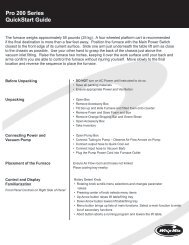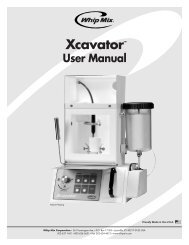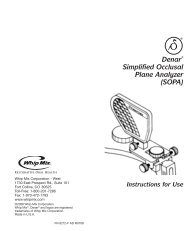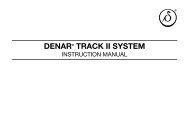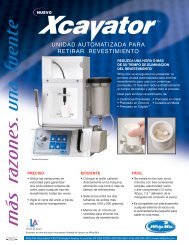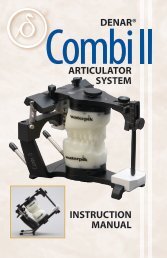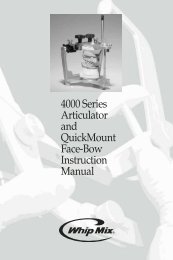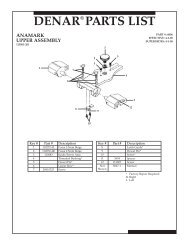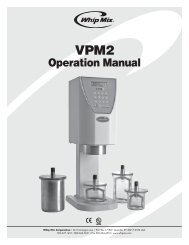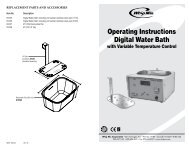Mark II Instruction Manual - Whip Mix
Mark II Instruction Manual - Whip Mix
Mark II Instruction Manual - Whip Mix
You also want an ePaper? Increase the reach of your titles
YUMPU automatically turns print PDFs into web optimized ePapers that Google loves.
Clamp<br />
fig. 42 fig. 43<br />
At this point you will be ready to attach<br />
the facebow side arms. Note that they<br />
are marked right and left and refer to the<br />
patient’s right and left. Make sure that<br />
the scales on the posterior reference<br />
slides are adjusted to their zero positions.<br />
A. Facebow Application<br />
Remove the nylon earpieces on both<br />
the posterior reference slides and begin<br />
the attaching of the side arms (fig.<br />
43). First you will need to locate the<br />
right side arm on the crossbar so that<br />
the lockscrew on the crossbar clamp<br />
faces upward and the posterior reference<br />
pin at the end of the posterior<br />
reference slide lightly touches the<br />
posterior reference point. Secure the<br />
side arm clamp to the anterior crossbar.<br />
Then attach the left side arm<br />
similarly.<br />
B. Earbow Application<br />
Make sure the nylon earpieces are on<br />
both posterior reference slides. Position<br />
the right arm on the crossbar so<br />
that the lockscrew on the crossbar<br />
clamp faces upward and the nylon<br />
earpiece fits snugly in the external<br />
auditory meatus. Secure the side<br />
arm clamp tightly and attach the left<br />
side arm similarly.<br />
At this point the facebow/earbow records<br />
the relationship of the maxillary<br />
dental structure to the posterior reference<br />
points. The only thing remaining to<br />
be done is to relate the maxillary dental<br />
structures to the anterior reference<br />
point.<br />
Insert the reference rod into its clamp<br />
bringing it up from underneath the<br />
clamp, with the step in the rod facing<br />
toward the patient’s right (fig. 44). Hold<br />
the reference plane locator between the<br />
thumb and index finger of your left hand<br />
so that you can read the instructions<br />
on the back. The semilunar notch on<br />
the locator’s inferior surface should be<br />
placed over the bridge of the nose. Note<br />
the small hole in the center of the locator.<br />
Turn the locator down flat so that the<br />
instruction side faces downward and<br />
index the hole on the locator over the<br />
small dowel-like projection on the upper<br />
extremity of the reference rod. Position<br />
your eye approximately six inches<br />
in front of the locator. By line of sight<br />
adjust the locator by inclining it anterioposteriorly<br />
and medio-laterally until a<br />
projection of its broad surfaces pass<br />
through both posterior reference points<br />
as indicated by the posterior reference<br />
slides (fig. 45). At this time the anterior<br />
reference point marked on the patient’s<br />
face may be above or below the reference<br />
plane locator.<br />
Adjust the height of the reference rod so<br />
that a projection of the locator’s broad<br />
surfaces passes through the anterior<br />
reference point as well as the posterior<br />
23





